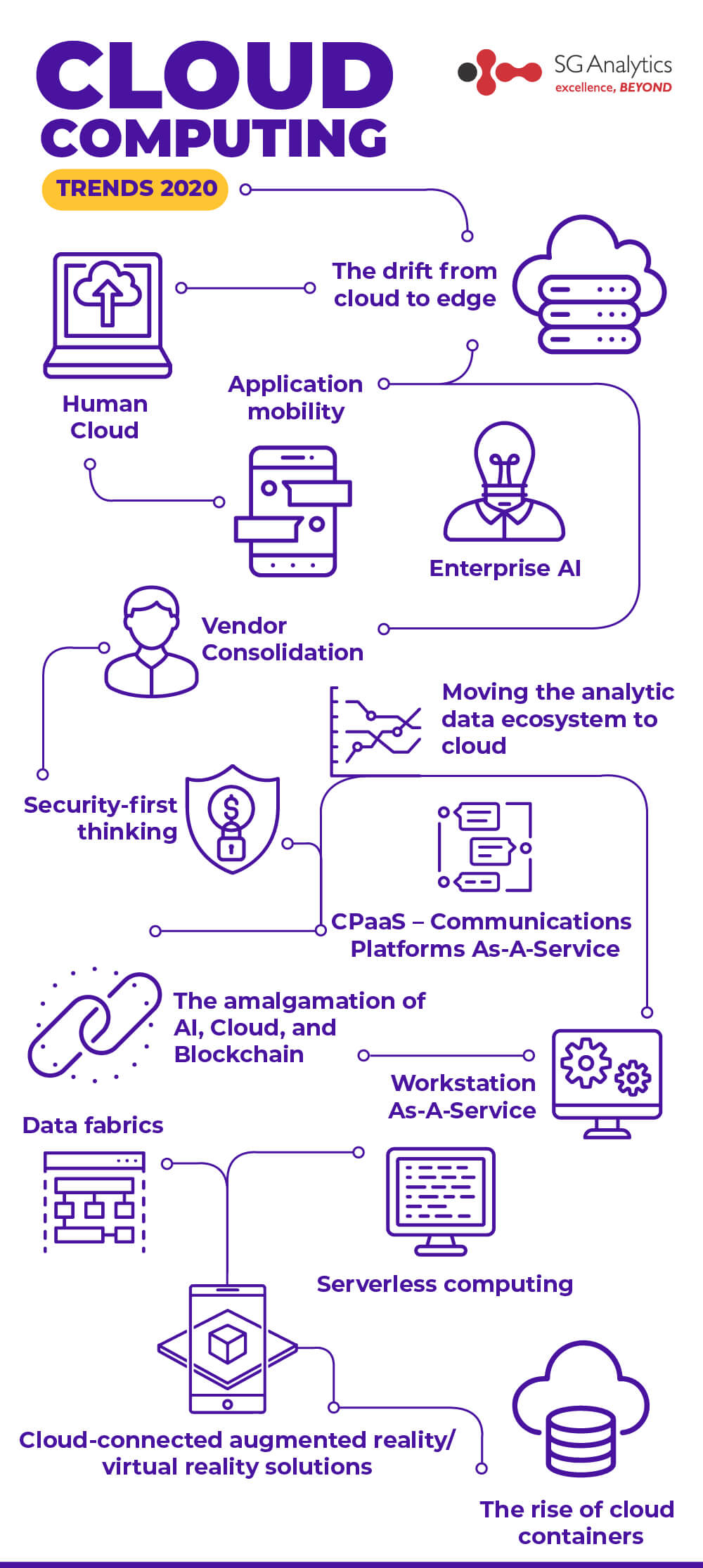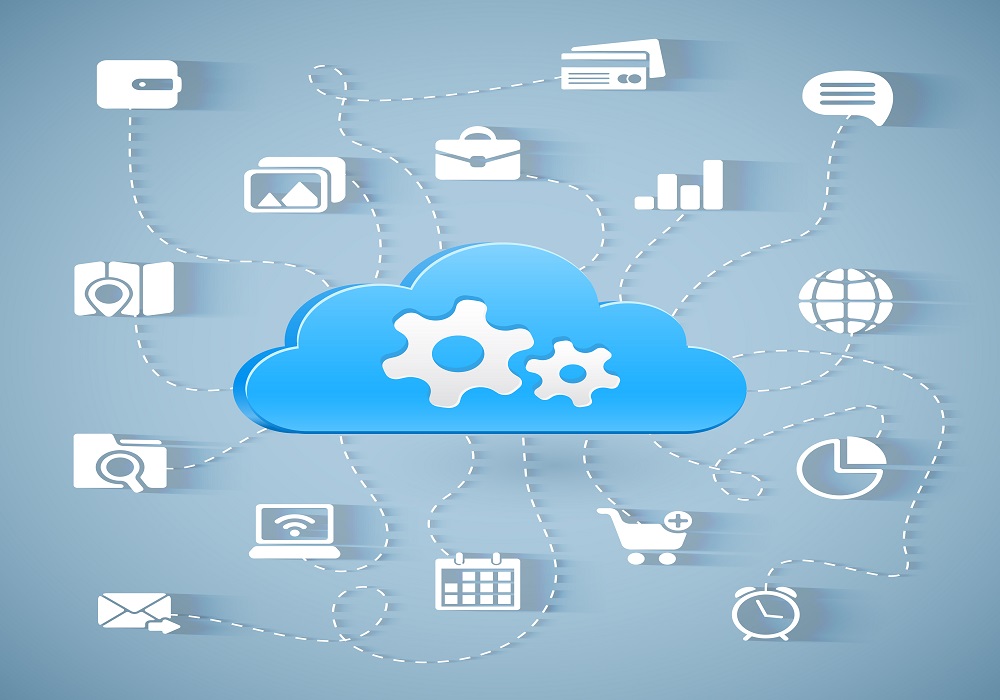Cloud computing is no longer an alternative rather an integral part of an organization’s network strategy. Besides cost, the other factors that drive companies to migrate to the cloud are accessibility, scalability, flexibility, easy implementation, among others.
Nearly one-third of an organizations’ IT budget is allocated for cloud services (Spiceworks, IDG). Almost 90% of companies are present on the cloud today (451). Following are the new trends in cloud computing that will reshape enterprise computing in 2020 and the years ahead:
The drift from cloud to edge
Cloud processing will further evolve, mainly for wide-scale data analytics and processing. While AI and ML will happen in the cloud, localized processing will gradually move to the edge. With 5G coming into the picture, processing will be much faster for IoT devices at the edge.
Human cloud
“Talent gap” is a major issue faced by most tech departments across the world. Human cloud is an emerging cloud computing trend in the B2B sector that allows organizations and employers to find the right talent for a particular job. Human cloud basically refers to all types of online platforms and digital work marketplace that allow employers to find and employ workers on various projects. According to stats provided by SIA, 75% of transactions in the B2B human cloud include IT and creative job categories. In short, the human cloud provides on-demand access to a well-measured, flexible, and vast talent pool.
Application mobility
Enterprises are keen to overcome siloed dependencies on a specific cloud, so they can easily move applications between private clouds, public clouds, and edge-computing locations, based on demand. Hence, application mobility is gaining traction as enterprises are actively shifting to the cloud
Enterprise AI
Artificial intelligence is rapidly advancing, so much so that it can drive transformation across every aspect of an organization.
Enterprises are increasingly adopting consumer-facing AI applications to provide better customer services. As a result, the demand for cloud among organizations will increase, as firms aim to have secure, scalable, and distributed AI technologies. Additionally, evolving distributed AI standards like Dask will play a major role.
Vendor Consolidation
A supply chain management strategy – Vendor Consolidation- is the process of shrinking the vendor base and collaborating with only the most successful suppliers within a supply market. Also known as supplier consolidation, this process began to gain momentum as companies began looking out for practical solutions to improve functionality and save more time and cost in supply chain management.
Security-first thinking
Security-first thinking will supercharge cloud adoption, as an integrated multi-platform segmentation strategy will enable enterprises to move securely to the cloud and avoid challenges of data sprawl. Also, the agile segmentation of apps, assets, and functions will reduce a company’s exposure to new risks that were not there before the cloud migration.
Moving the analytics data ecosystem to cloud
An increasing number of companies are moving their analytic data to the cloud to provide their users reliable, quick, and easy access to data. The key advantage of shifting the analytic data ecosystem to the cloud is the separation between storage and computation, as this enables users to load and process the same data set concurrently. This cloud computing trend also makes disaster recovery much faster and simpler and eliminates the need for expensive enterprise-licensed software. Even more, the shift leads to accelerated time-to-market for customized customer solutions.
CPaaS – Communications Platforms As-A-Service
The advent of the cloud has greatly revolutionized the IT industry. Today, many IT applications have moved to the cloud. However, telephonic applications are still deployed through on-premises equipment. This situation will change with Communication Platforms As-A-Service. At present many IT departments are using CPaaS offered by companies like Twilio, Nexmo, SignalWire, etc, to modernize their outdated telephonic applications and also to migrate them to the cloud.
The amalgamation of AI, Cloud, and Blockchain
There is a positive and symbiotic relationship between the three technologies – AI, Cloud, and Blockchain. The amalgamation of these three disruptive technologies will not only produce unlimited opportunities but will take an integrated approach to next-gen cloud architecture. Though currently under research and being experimented on a small scale, this triadic relationship will continue to grow and create networks with resources for efficiency.

.
Workstation As-A-Service
Workstation-as-a-service (WaaS) is a cloud offering engineered to enable employees access their office data and applications from any place, at any time, and using any device (desktop computers, laptops, smartphones, tablets, etc). While traditional remote workstation set up may take weeks or months, the emerging cloud computing trend, WaaS, enables companies to adapt rapidly and facilitates improved mobility and decreased power consumption. Even more, companies can trim IT expenditure while providing an environment where their employees can work smoothly and efficiently.
Data fabrics
Cloud computing is one of the most significant innovations in the technology space as it has solved as well as created problems. For example, cloud computing has created an expectation that programs must work anywhere and anytime. Data fabric – an amalgamation of technology and architecture – takes collaborative computing to the next step by facilitating frictionless access and data sharing in a distributed network.
Serverless computing
A cloud computing execution model, serverless computing, lets users to write and run codes without having to worry about the underlying architecture. In serverless computing, the cloud provider runs the server and dynamically allocates the machine resources, and charges the user on an as-used basis. A cloud computing execution model that has evolved into a ubiquitous approach, serverless computing, will completely revolutionize the way organizations do IT.
Cloud-connected augmented reality/virtual reality solutions
The fifth-generation mobile network, 5G, promises high bandwidth, low latency, and breakneck speed. 5G also enables cloud service providers to distribute their cloud computing services much closer to the users. As a result, there will be a drastic increase in cloud-connected Augmented Reality (AR) and Virtual Reality (VR) implementations. Pre-5G networks couldn’t technically support immersive technologies like AR and VR as these technologies need high processing power and bandwidth. With 5G, companies can now concentrate on constructing performant, cloud-connected AR and VR solutions.
The rise of cloud containers
According to Gartner, by 2023, over 70% of global organizations will be running more the 2 containerized applications in production. Similarly, as per IDC predictions, by 2021, 95% of micro-services will be used in containers. Container in cloud is a standard software unit that supports faster development across various environments. The ‘Build it once and run it anywhere’ capability of cloud containers has made it popular among organizations. Even more, cloud container simplifies management and removes operational concerns related to hybrid cloud.









